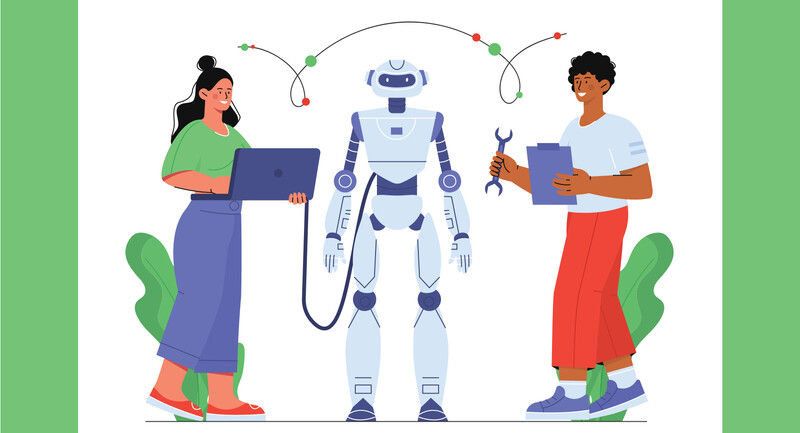June 26, 2023
•
•
Vol. 80•
No. 9In a Brave New (Writing) World, Let’s Hold on to Some Basics
Tech tools can ease many aspects of the writing process—but we still need to teach students the bedrock skills of writing.
Credit: artisteer / istock
I remember my first steps, as an English and writing teacher, into incorporating digital tech into teaching. In 2000, my second year of teaching, the staff in my school district got email addresses, and I remember how one teacher made the mistake of "replying all" to an email from the superintendent. The following year, I discovered that our school had one LCD projector available for checkout from the library. By fashioning a complex menagerie of cables, extension cords, and surge protectors, I could display my desktop computer screen on the pull-down projection screen for my high school English students. It was like magic.
I kept quiet about my lucky find, but at the time, most teachers had no interest in the LCD projector (or the patience to navigate the obstacle course of wires). I, however, did not hesitate to shift my instruction. After all, my classroom was equipped only with a brown chalkboard which, for unknown reasons, only tolerated a specific, ancient brand of yellow chalk. I "saved time" by no longer writing vocabulary, agendas, and due dates on the board; instead, I projected this information on a screen and added it to a class website. My students and I navigated our brave new world one click at a time. I modeled writing and revision with emerging digital tools, helping students become real-time editors. Taking advantage of the devices on our school's new computer cart, we revised thesis statements and first drafts, displayed and critiqued original poetry, and—when questions came up—searched the internet together for answers.
Next came computer labs for students, early versions of learning management systems, discussion boards, and teacher-created "webquests." More teachers got on board in using edtech. I remember my principal sharing an article about wikis because he thought it sounded like something I would like. I quickly fell in love with wikis, combining that tool with Crocodoc (does that ring a bell for anyone?). My creative writing students crafted collaborative multi-modal stories on wikis, while Crocodoc allowed my Honors English students to peer edit in a paperless environment for the first time. Such early collaborative models quickly made way for Google Docs, Zoom, and the Chromebooks that dot our learning landscapes today.
I look back now at my early efforts in using technology and see charming lesson experiments and more than a few miscalculations. More than once, I allowed my fascination with technology to eclipse the focus of my English lessons. As time went on, I became less enchanted by new tech programs; as much as I missed the excitement of those early days of education's technological revolution, I longed for a return to direct engagement with content. I wondered if I wasn't spending more time teaching how to use technology than how to write thoughtfully and critically. I wanted my students to harness the power of words, not just the power of technology, and to do this, they needed a deep understanding of language. I remember looking over the sessions at the 2014 National Council of Teachers of English convention and feeling relief that tech-focused sessions were no longer dominating, and we were finally returning our focus to reading, writing, and storytelling.
I admit, I still feel a tug of war—one side of me wants to return to basics, but the other side is enamored with the next big thing and addicted to innovation and breakthrough tools. I want to be on the cusp of something monumental in education, and I want my students there with me.
But I also want to hold on to good ideas—fundamental ideas—especially about writing.
The answer to this question, it seems to me, is both yes and no. More than 30 years ago, Ernest Balajthy (1985) noted that with the advent of word processing, student writers would now be able to easily engage in revision, which had been "long advocated but ignored by both teachers and students as too mechanical and painful" (p. 25). Most writers, professional and novice, would surely agree that computers have revolutionized the process of revision. The nature of writing, however, hasn't changed, and revision can still be painful—just for different reasons. Writing is still hard and at many times solitary. Writers often depend on themselves for initial, generative ideas. And they need to cultivate a discerning eye, a thick skin, and an actual will to revise. Technology surely helps with some of this—but does it change the whole game?
Collaboration also helps the writing process. The collaborative features of the Google suite have recast the feedback loop that English teachers try to establish with student writers. We can invite more people into that loop, including classroom peers, writing center consultants and tutors. The more writers' eyes on a piece, the better. Having students engage with each other's work is easier than ever, and it is engagement that grows writers.
For example, a high school student may learn from reading another's work that yes, you can begin a sentence with the word "Because." Subsequently, that student will abandon their allegiance to an old rule of writing ingrained years ago at a different developmental stage. Such seemingly small gains can occur unnoticed, as students work asynchronously on Google Docs. These gains compound as exposure increases and students continue to view each other's work through critical lenses. Collaboration engenders opportunities for growth, and often the teacher may not be involved or even aware.
In addition to collaborative opportunities made possible through shared files and real-time editing, writers can now take advantage of tools like Grammarly, predictive text, and a dictionary full of synonyms only a right-click away, tools that make writing and revision easier than ever. Robert Murphy (2019) classifies these types of tools as "narrow AI," a type of artificial intelligence that can "perform a single, specific function" (p. 2). Most writers have come to appreciate this assistance. Students can even generate citations in MLA style, Chicago style, and more simply by accessing tools built into Google Docs.
But collaborative tools and narrow artificial intelligence shortcuts aren't a replacement for the writing process—a process that begins with a germ of an idea, a turn of a phrase, a desire to communicate, and includes personal exploration and discovery. These tools are merely conveniences provided by technology, some by a type of artificial intelligence that is inherently limited and may actually fail to meet some of our expectations. They will likely continue to improve, but even if such tools were to remain only as effective as they are now, they would adequately meet most writers' (and most writing teachers') needs for helpful shortcuts. When I talk about writing with colleagues at the high school and college level, they express comfort with current tools and their uses. They appreciate predictive text in emails, but still love to laugh knowingly when the suggestions miss the mark.
So it seems to me that for a moment in the third decade of this century, many writing teachers have stalled in our relationship with edtech. We've moved past the initial thrill of technology for technology's sake. We no longer rush to add the latest fad to our lessons. We want to focus on the basics and use technology to enhance, not replace, the foundations of writing. We have grown accustomed to the status quo—using narrow AI—and as tools like thumb drives and Prezis have come and gone, we've continued teaching writing.
But late last year, Daniel Herman's "The End of High School English" (2022) was published in The Atlantic. This vanguard piece posited that "the majority of students do not see writing as a worthwhile skill to cultivate," and that many writing tasks would be better achieved by a new generation of AI tools, ones that were stronger, better, faster. Soon after this, Elon Musk (2022) tweeted that "ChatGPT is scary good. We are not far from dangerously strong AI."
Subsequent articles, blog posts, and Twitter rants ran the gamut in response. The paradigm-shifting potential presented by ChatGPT and other generative AI platforms began to pit teacher against teacher; some saw it as a disaster, some welcomed it as a game-changing instructional resource. In a matter of days, everyone had an opinion, and many fell victim to that same Zeitgeist of divisiveness that pervades our nation, our politics, and our everyday interactions. Teachers were deemed either Luddites incapable of adjusting or foolish dreamers willing to sacrifice a bedrock of education for flights of fancy. Some found solace in the idea of returning to paper and pen, while others jumped to inform their students of new possibilities for writing.
Hearing all this, it seems to me that once again, many educators are focusing more thought on the technology used for writing than on the writing itself—or the question of how to teach young people writing skills.
The dust has now settled somewhat. Companies have rushed in to offer detection services that can tell (at least for the time being) whether a text was written by ChatGPT, students have become more aware of the nuances of AI and its problems as well as temptations, and writing teachers have begun to experiment. What remains to be seen, however, is how we will meet this moment, as teachers and students. Will we recognize the true danger of AI writing tools? In my view, that danger is not students cheating. That danger isn't a teacher using the tool to write a first draft of a letter of recommendation due the next day, or asking AI for help with brainstorming or grammar.
The danger is that we will stop teaching the fundamentals of writing altogether, that we will buy into the argument that the product—an error-free piece of writing—is more important than the process. Honoring the writing process often involves multiple drafts, peer editing, review, and polishing, but it also involves exercising critical thinking, organization, and decision-making skills. Through this, students develop nuanced vocabularies and more complex ideas. They are also better able to articulate their thoughts and understand the writing of others. Some will even become writers.
The current situation with AI tools bears resemblance to other arguments about product over process. For example, if a math student can pass the final exam without help (this "product" showing they understand the concepts), does it matter if that student did the homework? In English Language Arts, the equivalent question has a clearer answer than in math: The process is more important than the product. The slow, deliberate nature of learning to write, revise, and write again can be difficult, even painful, but that process strengthens many important skills.
Can AI alleviate some of the struggle? Probably. We need to determine which parts of the struggle are necessary for development and which parts are simply extra work for students and teachers. We need to determine the ways AI can enhance the writing process without eliminating it, incorporating these new tools with the goal of building stronger writers and thinkers. We have work to do, but it is exciting work. Writing teachers are pioneers again, and although the path before us is not yet clear, we've been at the intersection of technology and writing before. We can hold on to what we know is true about writing while adapting to what will certainly change.
References
•
Balajthy, E. (1985). Artificial intelligence and the teaching of reading and writing by computers. Journal of Reading, 29(1), 23–32.
•
Herman, D. (2022, December 9). ChatGPT will end high-school English. The Atlantic.
•
Murphy, R. F. (2019). Artificial intelligence applications to support K–12 teachers and teaching: A review of promising applications, opportunities, and challenges. RAND Corporation.
•
Musk, E. [@elonmusk]. (2022, December 3). ChatGPT is scary good. We are not far from dangerously strong AI. [Tweet]. Twitter.








